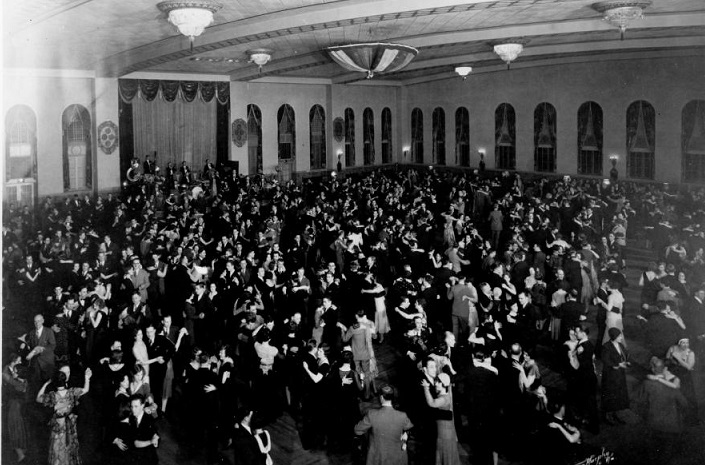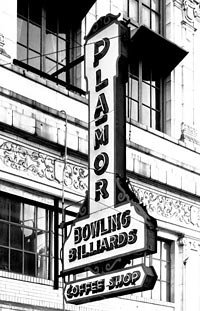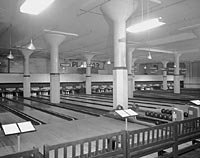On the evening of November 24, 1927, the Pla-Mor Ballroom opened at 3142 Main Street to a crowd of 4,100 who reveled at its unprecedented size and modern style. The facility followed in the footsteps of the Roseland Ballroom in New York, the Graystone Ballroom in Detroit, and the Aragon Ballroom in Chicago at the height of the Jazz Age of the 1920s.

Paul M. Fogel, the president of the Fogel Construction Company, built the ballroom that would help Kansas City become what ethnomusicologist Nathan W. Pearson describes as the fourth major city of Jazz behind New York, New Orleans, and Chicago. For the design, Fogel hired Charles A. Smith, an architect known for his work on public schools in Kansas City. The facility cost over $500,000, contained a 14,000 square foot dance floor, and held luxuries such as Italian furniture and plush carpet.

On opening night, the ballroom’s multi-colored electric lighting dazzled thousands of dancing patrons who were serenaded by the Jean Goldkette Orchestra. Dancers found an extra bounce in their step because of the 7,000 springs beneath the wooden floor that flexed up to one quarter of an inch. Famous jazz musicians appearing at the ballroom in the subsequent two decades included Tommy and Jimmy Dorsey, Bix Beiderbecke, Frankie Trumbauer, Joe Venuti, Glenn Gray, Vincent Lopez, Larry Clinton, Stan Kenton, and Ella Fitzgerald.
But it was more than just a jazz attraction; it was the largest indoor entertainment complex in America. The lower floors included a bowling alley and billiards. Next door sat an ice skating rink which hosted the Kansas City Greyhounds ice hockey team and an annual Ice Capades show. In 1931, Pla-Mor added the largest swimming pool west of the Mississippi River.

The Pla-Mor maintained its large crowds until changing social mores lessened the attraction of ballroom entertainment and suburbanization in the 1940s began to draw population from the heart of the city. The ballroom ceased business in 1951, and the other attractions closed in later years. In 1972, the building was razed to make way for a car dealership.
Read a biographical sketch of Charles Ashley Smith, Architect, prepared by Susan Jezak Ford, Missouri Valley Special Collections, The Kansas City Public Library.
View images of the Pla-Mor facilities that are a part of the Missouri Valley Special Collections:
- Christmas Pageant at the Pla-Mor Ballroom
- Margaret Field, ice skater, performing at the Pla-Mor Amusement Center
Check out the following books about the Pla-Mor Ballroom:
- Kansas City Jazz: From Ragtime to Bebop – A History, by Frank Driggs and Chuck Haddix; contains a short description and other references to the Pla-Mor Ballroom, pp. 59-61.
- Kansas City Style: A Social and Cultural History of Kansas City as Seen through its Lost Architecture, by Dory DeAngelo & Jane Fifiled Flynn; contains a profile of the Pla-Mor Ballroom, with photographs, pp. 158-159.
- Goin’ to Kansas City, by Nathan W. Pearson, Jr.; contains little information on the Pla-Mor Ballroom, but does cover Kansas City jazz; based on interviews.
Visit the American Jazz Museum at 1616 E. 18th St., Kansas City, MO 64108, (816) 474-8463.
Continue researching the Pla-Mor Ballroom using archival material from the Missouri Valley Special Collections:
References:
Dory DeAngelo & Jane Fifield Flynn, Kansas City Style: A Social and Cultural History of Kansas City as Seen through its Lost Architecture (Kansas City, MO: Harrow Books, 1990), 158-159.
Frank Driggs and Chuck Haddix, Kansas City Jazz: From Ragtime to Bebop – A History (New York: Oxford University Press, 2005), 59-61.
Rick Montgomery & Shirl Kasper, Kansas City: An American Story (Kansas City, MO: Kansas City Star Books, 1999), 196.
Nathan W. Pearson, Jr., Goin’ to Kansas City (Urbana: University of Illinois Press, 1987), xviii.

